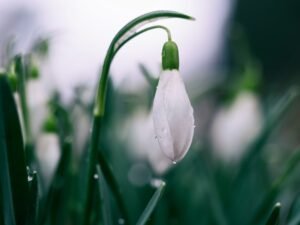Larkspur, with its tall, elegant spikes of colorful flowers, is a stunning addition to any garden. This beautiful flower belongs to the Delphinium family and is known for its vibrant hues and delicate petals. Larkspur comes in a variety of colors, including shades of blue, purple, pink, and white, making it a versatile choice for gardeners looking to add a pop of color to their outdoor space.
Not only is larkspur visually appealing, but it also attracts pollinators such as bees and butterflies, making it an excellent choice for those looking to create a pollinator-friendly garden. Additionally, larkspur is relatively easy to grow and care for, making it suitable for both experienced gardeners and beginners alike.
Key Takeaways
- Larkspur is a stunning addition to any garden, with a wide variety of colors and shapes to choose from.
- When planting and growing larkspur, it’s important to choose the right variety for your climate and soil, and to provide plenty of water and fertilizer.
- Proper care for larkspur includes regular watering, fertilizing, and pest control to keep the plants healthy and vibrant.
- Harvesting larkspur requires careful cutting and preserving techniques to ensure the flowers last as long as possible.
- Larkspur is a versatile flower that can be used in a variety of floral arrangements, and has deep symbolism and cultural significance in art and literature.
The Different Varieties of Larkspur: Which One to Choose?
There are several different varieties of larkspur to choose from, each with its own unique characteristics and growing requirements. Some popular varieties include the Pacific Giant larkspur, the Rocket larkspur, and the Imperial larkspur.
The Pacific Giant larkspur is known for its tall spikes of flowers that can reach heights of up to six feet. This variety comes in a wide range of colors and is often used as a cut flower due to its long stems. The Rocket larkspur is another popular choice, known for its vibrant colors and compact growth habit. It is a great option for smaller gardens or containers.
When choosing a variety of larkspur for your garden, consider factors such as the available space, desired height, and color scheme. It’s also important to check the specific growing requirements for each variety to ensure it will thrive in your garden.
How to Plant and Grow Larkspur: Tips for a Successful Garden
Larkspur is typically grown from seeds, and the best time to plant them is in the early spring or fall. Before planting, prepare the soil by removing any weeds or debris and loosening it with a garden fork or tiller. Larkspur prefers well-draining soil, so if your soil is heavy or clay-like, consider adding organic matter such as compost to improve drainage.
Choose a sunny location for your larkspur, as they require at least six hours of direct sunlight per day. Once the soil is prepared, sow the seeds directly into the ground, spacing them about 12 inches apart. Lightly cover the seeds with soil and water gently to ensure good seed-to-soil contact.
Larkspur Care: Watering, Fertilizing, and Pest Control
| Care | Frequency | Method |
|---|---|---|
| Watering | Once a week | Water deeply at the base of the plant |
| Fertilizing | Every 4-6 weeks | Use a balanced fertilizer with equal parts nitrogen, phosphorus, and potassium |
| Pest Control | As needed | Use insecticidal soap or neem oil to control aphids, spider mites, and other pests |
Larkspur requires regular watering to keep the soil moist but not waterlogged. Water deeply once or twice a week, depending on rainfall and temperature. Avoid overhead watering, as this can lead to fungal diseases. Instead, water at the base of the plants to keep the foliage dry.
Fertilize larkspur with a balanced fertilizer once a month during the growing season to promote healthy growth and abundant blooms. Be sure to follow the instructions on the fertilizer packaging for application rates.
While larkspur is generally resistant to pests and diseases, there are a few common issues to watch out for. Aphids and slugs can sometimes be a problem, especially in humid conditions. To control aphids, spray the plants with a strong stream of water or use an insecticidal soap. For slugs, set up beer traps or use organic slug control methods.
When and How to Harvest Larkspur: A Guide to Cutting and Preserving
The best time to harvest larkspur is when about half of the flowers on the spike have opened. This ensures that the remaining buds will continue to open once the flowers are cut. Use sharp, clean scissors or garden shears to cut the stems at a 45-degree angle, just above a set of leaves.
To preserve larkspur, remove any leaves that will be submerged in water and place the stems in a vase filled with fresh water. Change the water every two to three days to keep it clean and prevent bacterial growth. Larkspur can last up to a week in a vase if properly cared for.
Larkspur in Floral Arrangements: Ideas and Inspiration

Larkspur is a versatile flower that can be used in a variety of floral arrangements. Its tall spikes make it an excellent choice for adding height and drama to bouquets and centerpieces. Larkspur pairs well with other garden flowers such as roses, peonies, and snapdragons.
For a romantic and whimsical arrangement, combine larkspur with delicate flowers such as baby’s breath and Queen Anne’s lace. For a more vibrant and colorful look, mix larkspur with other bold blooms like sunflowers and zinnias.
Larkspur Symbolism and Meaning: What Does this Flower Represent?
Larkspur has long been associated with feelings of love, affection, and positivity. In the language of flowers, larkspur symbolizes an open heart and a joyful spirit. It is often given as a gift to express feelings of love, friendship, or congratulations.
In addition to its positive symbolism, larkspur is also believed to have protective qualities. In some cultures, it is thought to ward off evil spirits and bring good luck to those who possess it.
Larkspur Folklore and History: Tales and Legends from Around the World
Larkspur has a rich history filled with folklore and legends from around the world. In Greek mythology, larkspur was said to have sprung from the blood of Ajax, a hero of the Trojan War. It was believed that larkspur had the power to heal wounds and protect against evil spirits.
In medieval Europe, larkspur was associated with love and romance. It was often used in love potions and spells, and young women would wear garlands of larkspur flowers to attract suitors.
Larkspur in Art and Literature: A Cultural Icon
Larkspur has been a popular subject in art and literature throughout history. In paintings, larkspur is often depicted as a symbol of beauty, grace, and elegance. It has been featured in works by famous artists such as Vincent van Gogh and Claude Monet.
In literature, larkspur is often used as a metaphor for love, longing, and the fleeting nature of beauty. It has been mentioned in poems by renowned poets such as William Shakespeare and Emily Dickinson.
Embrace the Beauty of Larkspur and Enjoy its Many Wonders.
In conclusion, larkspur is a stunning flower that can add beauty and elegance to any garden or floral arrangement. With its vibrant colors, tall spikes, and delicate petals, it is sure to capture the attention of anyone who sees it.
Whether you choose to grow larkspur in your garden or incorporate it into your floral arrangements, you are sure to be delighted by its beauty and versatility. So why not embrace the wonders of larkspur and enjoy all that this remarkable flower has to offer?
If you’re interested in learning more about larkspur and its fascinating properties, you might also enjoy reading an article on Just Tidings titled “The Link Between Iodine Levels and Men’s Testosterone Levels.” This thought-provoking piece explores the connection between iodine, a vital nutrient found in larkspur and other sources, and its impact on men’s testosterone levels. Discover how maintaining optimal iodine levels can potentially enhance overall health and well-being. Check out the article here.




















+ There are no comments
Add yours